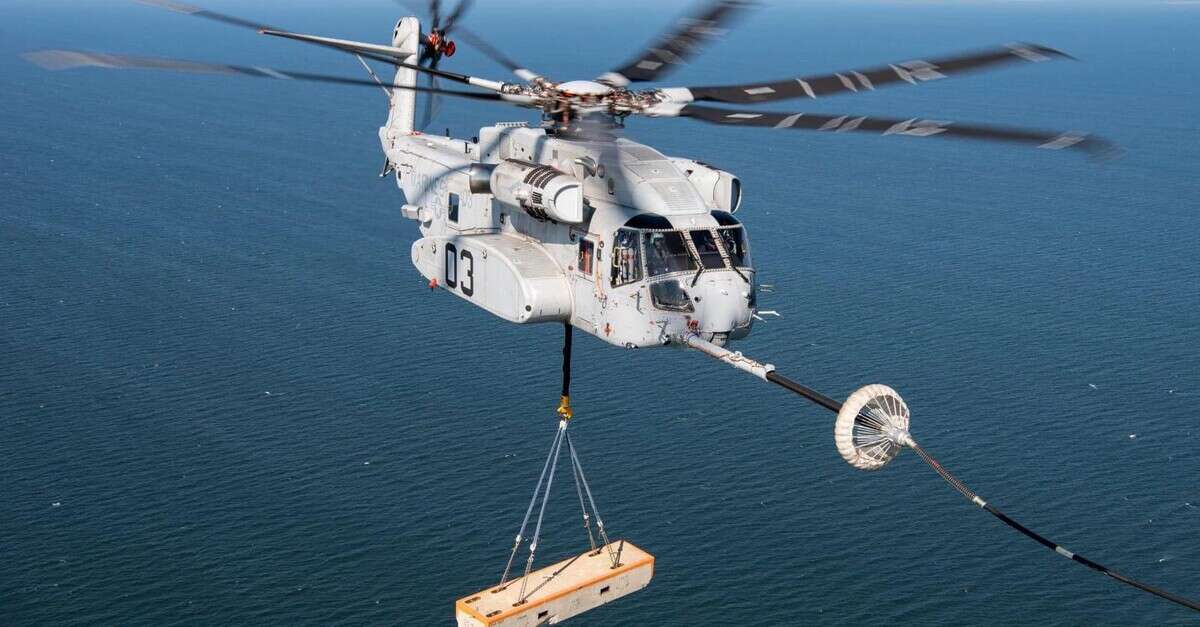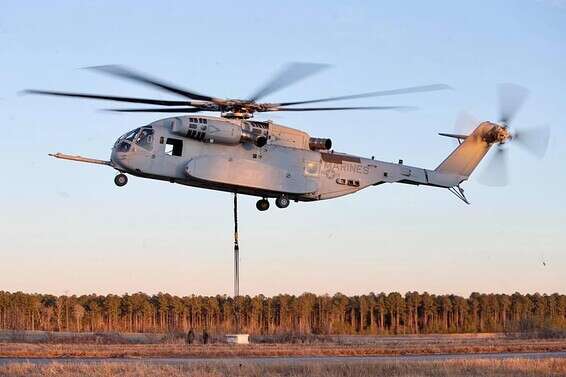
Gantz said that “the decision to purchase new assault transport helicopters for the Air Force, after decades, is a significant step in the IDF’s force building and is essential for carrying out a wide range of routine and combat operational tasks. The new helicopter is adapted to the operational needs and challenges of the changing battlefield. ”
It was also stated that “the decision was made after professional staff work that included flights in all the proposed helicopters, as well as examining the various alternatives in terms of engineering, technology, maintenance and more. All details, including the number of helicopters requested, will be approved by the Ministerial Committee as soon as possible.” Following the announcement, we inquired about the benefits of the IDF’s new helicopter.
CH53K’s first test flight in the Navy service // Photo: Lockheed Martin
Nehemiah Dagan, a lieutenant colonel in the reserve and commander of the First Storm Squadron, explains that the choice of Sikorsky and not Chinook stems from the IDF’s emphasis on special operations, in parallel with the transport flights.
“The Chinook helicopter is a kind of huge crane. It can take a very heavy load from one protected place to another protected place. This is its strength and advantage, but it is also the reason why it is not suitable for the IDF. In the IDF, the stormtroopers are not only transport helicopters, but they are also helicopters for special operations – and in this area the Chinook is not a default. This is in contrast to the Sikorsky ordered for the Marines, which is a maneuvering helicopter that can operate in combat conditions Both for transport and for the transport of special forces.
“In addition,” Dagan explains, “Chinook has two rotors (propellers), which makes it more vulnerable. The most vulnerable point in a helicopter is its rotors, and when there are two rotor rods the helicopter is more vulnerable than with one rod as Sikorsky has.

“By the way, even before they took on the storms in the IDF in 1969, there was exactly the same debate about whether a helicopter was needed only for transport or special operations, and even then there was an argument between the storm and the Chinook helicopter – and for the same reasons the storm was chosen,” Dagan recalled. We became obsolete and needed a new storm, so they chose the Sikorsky that could carry a lot more load. It is at the level of the F-35 in relation to the helicopters of the past, ie a helicopter of the current generation which is all about technology and digital capabilities, beyond of course its maneuvering powers in special operations and under fire.
“Of course it’s a stronger and wider helicopter, but it’s like the same helicopter will take off – just really strong, modern and reliable. Like they took the old storm and built something similar with all the good things the modern world has to give the helicopter today. That’s also why the Marine Corps wanted it. “The Chinook is suitable for the American land forces that carry things with it, but for operations, for assault capabilities – you need something like the storm that will be strong, fast, reliable and with long-range capabilities.”
The Lockheed Martin Challenge
According to a source involved in the deal, this is the most advanced and heavy Western helicopter in the world, which can carry twice the weight of the stormtrooper helicopter. “In terms of their structure, these are very similar helicopters to storm helicopters, because the US Marine Corps specifically requested a similar helicopter so that they would not have to change the structure of its helicopter carriers at all.
“This posed a challenge to Lockheed Martin, who built a helicopter that looked similar to the Yasur. However, the helicopter has three engines facing the two of the Yasur, it can fly at 170 knots in an emergency to 210 knots in front of the Yasur flying at 120. Beyond that, they added a rotor Bend the ends of the rotors so that the maneuverability and lift of the helicopter are better.To explain how much stronger and better the helicopter is, it can be said that it will be refueled from a Hercules aircraft carrying a weight of 12 tons on the outside.That despite the cargo movement under the helicopter Refuel in this situation, which is a huge challenge for a helicopter with a heavy load. ”

The source also noted that the entire helicopter is much more technological and computerized, without any outdated analog system. He said, “The cockpit is computerized and the helicopter flies itself, which puts a lot of pressure off the pilots, who are immersed in their main task. The helicopter’s computing also allows more room for more things in the back, which is also a serious factor.
“Beyond that, as in today’s vehicle, all the helicopter’s information connects to the computer. In the event of an oil leak then in the old storm helicopters the whole oil system had to be disassembled to find the problem. Here the helicopter’s computer knows to direct the technician exactly where the leak is. “Or the defective part. It greatly shortens the maintenance period, allows the helicopter to be in the air for a very long time and reduces the maintenance time on the ground.”
“Suitable for carrying huge loads”
In general, the field of maintenance was, according to the source, the main consideration that caused the Air Force to choose CH53K. “You should know that the Sikorsky is more expensive than the Chinook and yet the Air Force chose it, because in terms of spare parts and maintenance over time the spare parts and maintenance are very cheap. When you buy a 50 year old transport helicopter you need to have spare parts all the time. Few glitches, so in the long run Sikorsky is cheaper.
“The IDF Storm Squadron, for example, has had a problem in recent years finding spare parts because there were no spare parts for helicopters on the market. There were almost no air forces using the storms anymore, and that was a difficult problem. In this respect the Sikorsky is a helicopter with few engine parts and few parts that can be damaged and cracked. They are easy to replace and are very inexpensive. Therefore, for the period of 50 years ahead, the helicopter will greatly return the investment in it, “he said.
Beyond that, in terms of carrying weight and flight range, the Sikorsky helicopter can fly without aerial refueling while carrying full weight for an incredible range of 2,000 kilometers – which covers for the IDF the entire Middle East and countries in the far periphery of the Middle East. Which allows doubling of this distance.
The source also says that “the storm can carry 42,000 pounds and the new helicopter can carry 91,000 pounds, which is a lot of power and a lot of load for these distances. The helicopter carried in practice the new armored jeep of the American Marines.”
“Even though the helicopter has three engines, its noise is the same in intensity as the two engines of the storm, which means it will no longer stand out in the field. However, it has no elusive technology because the Americans built a transport helicopter here, which is what the IDF asked for. Of course, the Israeli Air Force will be able to install any device it wants on it, it does not depend on the company. The helicopter is suitable for carrying huge loads for the long term, whatever they put on it and other capabilities – this is what the Air Force will choose. “